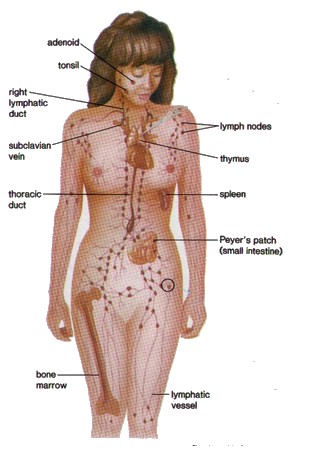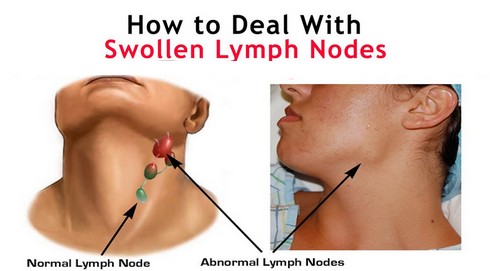

The "Other" Bloodstream
(Lymphatics)
Did you ever pop a blister and noticed the clear liquid inside? This is lymph, a yellowish fluid that flows, or rather is "squeezed" throughout body in its own private circulation system. Whole blood does not flow in the tiny vessels that make up the lymphatic network. Neither does the heart make it move. Only the massage of contracting muscles and its own emptying, when tube fullness causes a contraction, moves the fluid along.
 Before we describe this life-sustaining system, why do we need it? Surely lymph must have more uses than to fill blisters!
Before we describe this life-sustaining system, why do we need it? Surely lymph must have more uses than to fill blisters!
As the blood flows under pressure through tiny vessels called capillaries, often a large protein in the blood will leak through the wall of the tiny vessel and become trapped in nearby tissue. There is no way for it to be reclaimed, and the result is that it lowers the overall blood pressure and protein content necessary to keep the body in repair.
Not only that, but these proteins can become compacted and interfere with cellular breathing (respiration). Any cell "short of breath" is a cell
that’s going to weaken, produce less energy, and eventually smother in its
own toxic waste products. It does not die in silence however, and will
exhaust all avenues in attempting to save itself. One of the ways it cries for
help is to transmit a message: PAIN.
Coming to the rescue is a whole network of tiny vessels interwoven between the cells. They are able to scavenge the blood proteins, absorb
them back and eventually return them to the blood. This is the job of the
lymphatic system. In addition, they collect invading tissue bacteria and
foreign particles.
Just like the blood vessels, these tiny tubules converge into larger
systems. At certain points they flow into a "node" which is filled with
antibodies to attack and digest various microbes that are gathered along
with the blood proteins from various tissue sites.
In addition to these node antibodies (lymphocytes), special cells inside each node are also able to process foreign proteins or chemical particles recognized as dangerous to the body. You can easily see that if any of the nodes are overwhelmed with toxic materials, that they would become swollen, and eventually infected.
One of the major causes of edema (tissue swelling) is a clogging of the
lymphatic function. Another cause in the South Sea Islands is a tiny parasite
which may allow a leg, for example, to swell to the point where it weighs
as much as the rest of the body.
Another problem is the build-up of too much toxic waste matter. This initiates a break down in these delicate vessels. Poisonous chemical warfare gases have caused this kind of damage in lung tissue.
Although these tiny vessels are able to contract and push their load toward a node, poor nutrition or general weakness may cause the expanded
vessels to hold on to their contents instead. To help them do their job, the movement of the body during exercise helps to squeeze fluid forward.
Little valves close behind each contraction and keep the liquid from backing up. We also find these same one-way valves in blood veins within the legs.
Their main responsibility is to return blood to the heart.
In a word, the lymphatic system completes the train of events that feed and nourish every cell. Whereas the blood brings oxygen, food and messenger-hormones to each cell, the lymph collects wayward blood proteins, waste products and microbes from the spaces surrounding each cell. These are then detoxified, the usable compounds are reclaimed, and a purified lymph fluid is returned to your bloodstream.
Key Herbal Products
KEY HOMEOPATHIC PRODUCTS
Red Root
(Included in the Lymphomax combination above)
By Steven Horne (extracts)
 In the mid 1980s I met a gentleman doing live blood cell
analysis. He had worked with numerous AIDS patients and
told me that they all had three symptoms: an enlarged spleen,
a low platelet count, and swollen lymph nodes. He introduced
In the mid 1980s I met a gentleman doing live blood cell
analysis. He had worked with numerous AIDS patients and
told me that they all had three symptoms: an enlarged spleen,
a low platelet count, and swollen lymph nodes. He introduced
me to red root, Ceanothus Americanus, also known as New Jersey
tea, which routinely cleared up all three of these symptoms in
about 4-6 weeks.
A short time later, I had an opportunity to test this information. I was helping a person with AIDS who informed me that he was having trouble with a low platelet count. I suggested he try red root, and the problem cleared up right away. Several years later, he called me and told me he was again having problems with low platelet counts. I reminded him about red root, and again it quickly resolved the problem.
After this, I started using red root regularly for cases involving swollen lymph nodes and lymphatic congestion. I found
it combined very well with echinacea for these conditions. I used it for mumps, chronic sore throats, tonsillitis, swollen
Iymph nodes in the neck or groin, children and adults with
frequent earaches and even on a case involving Hodgkin’s
Lymphoma - and found it to be an incredibly dependable
lymphatic remedy.
Lymphomax contains red root, so our clients can obtain the benefits of this valuable remedy. Lyrnphomax is very helpful for clearing lymphatic congestion and shrinking swollen lymph nodes.
|